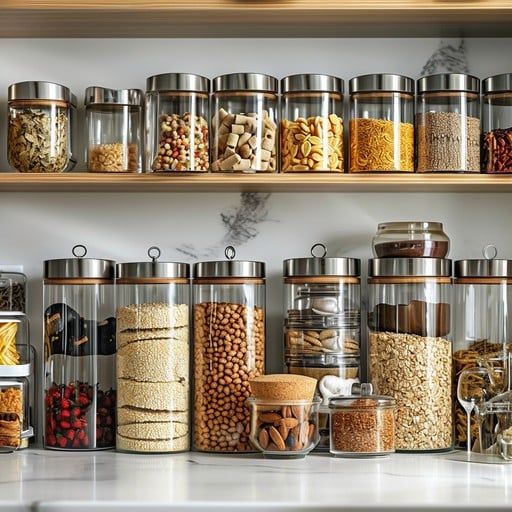8 Simple Organising Tips to Take Your Pantry From Overwhelming to Orderly
Without a proper system of organisation, your pantry can quickly become cluttered with expired items and duplicate products. Spills and leaks may go unnoticed for days, and the things you need can easily get lost in the chaos. Fortunately, there are many effective ways to keep your pantry tidy from grouping items into categories and using clear containers, to labelling both containers and shelves.
The guide below outlines some of the most helpful and commonly used tips to keep your pantry clean and free from clutter.
1. Remove Everything from the Pantry
Begin by taking all items out of the pantry and placing them on your kitchen worktop. Although it might feel counterproductive, many professional home organisers recommend completely emptying the space as the essential first step towards creating and maintaining an organised pantry.
Removing everything allows you to spot expired goods or items you no longer use, and to group the rest into useful categories. It also provides the perfect opportunity to give your shelves a proper clean.
2. Deep Clean and Declutter
Before returning items to the pantry, go through everything and discard anything that is expired, stale, or unlikely to be used. Be thoughtful about what you keep, especially if space is limited. Donate what you can and dispose of the rest.
This is also the best time to give the pantry a deep clean. Wipe down all shelves thoroughly, especially in places where spills or residue may have built up over time.
Tip: To protect the shelves from future marks and scratches, consider using shelf liners before restocking.
3. Group Pantry Items into Categories
To build a more functional system, start by sorting everything into categories. This will make it easier to keep track of what you already have, avoid duplicate purchases, and ensure nothing gets forgotten and wasted.
Useful categories might include spices, tinned goods, dry food, baking ingredients, oils and vinegars, drinks, and snacks.
4. Use Clear Storage Containers
Pantries often look chaotic due to colourful and mismatched packaging crammed into a small space. Transferring your items into clear storage containers not only reduces visual clutter, but also allows you to see exactly what you have, spot when items are running low, and identify anything going off.
5. Create Dedicated Storage Areas
Once everything is categorised, assign a specific section of your pantry for each group. Begin by assessing the size of each category and the available space. Your pantry layout may influence where items should go, and you might want to adjust shelf heights to suit.
Think about how often you use each category. For example, if you bake frequently, place baking items within easy reach at eye level. Choose the right type of organiser for each group, a tiered shelf works well for tinned goods, while a rotating tray is ideal for oils and vinegars and can make use of corner space.
6. Label Containers and Shelves
After transferring your pantry items into their new containers, use a label maker to clearly mark each one. Labelling helps keep everything in its place and supports long-term organisation.
You should also label the shelves themselves. Labelling the front of each shelf with its designated category makes it easier for everyone in the household to return items to the correct spot and helps avoid disorganised clutter building up again.
7. Make Use of Vertical Space
If you are running out of room, make the most of your vertical space, including the back of the pantry door and any free wall areas. Door organisers can be very handy for smaller items like spices and tinned goods. Wall hooks can hold things like aprons, reusable bags, or barbecue tools.
Tip: Stackable storage containers that fit the height and depth of your shelves can increase capacity. You might also consider clip-on drawers or hanging baskets under existing shelves to make full use of available space.
8. Utilise the Floor
The pantry floor is often overlooked, but it can be perfect for storing bulky items such as paper towels, large kitchen equipment, or a small step stool. For a neater look, consider using large baskets on the floor to store packets of crisps, biscuits, and other snacks.


No responses yet